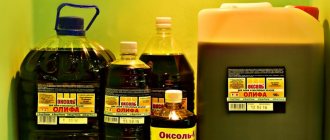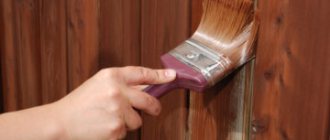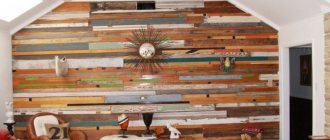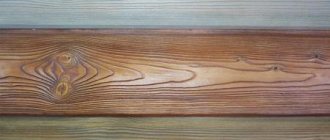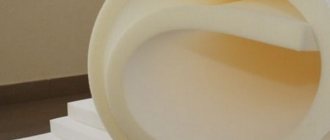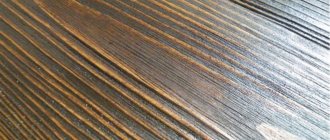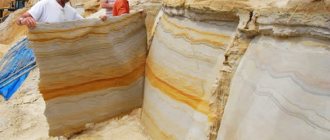Wood is often used in the construction of houses and other products. It is known that wood is destroyed under the influence of moisture and biological formations. For this reason, in order for the item to last longer, a protective surface treatment is required. The construction market offers a large number of products suitable for this purpose. But affordable stain has not lost its popularity for a long time. The features of white stain and the rules for its use will be discussed in detail below.
Features of using white wood stain
Stain is a paint and varnish product, but it does not cover the natural grain of the wood, but only creates a tinting effect and highlights the pattern. There is no film-like coating left on the surface. The fibrous texture of the wooden surface is impregnated with the composition to different depths, this gives the coating a relief and highlights the wood pattern.
This point depends on the following factors:
- The level of humidity of the base, better impregnation occurs when the structure is more humid;
- The degree of resin content of the base; to obtain better processing, coniferous wood is pre-prepared by removing excess resin;
- The degree of density of the material, the denser the wood, the more difficult it will be for the solution to penetrate inside. So on a dense area the shade will not be as saturated as on a less dense base;
- The shade of stain will vary depending on the type of wood;
- Age of the material, the younger the wood, the less dense it is.
The use of stain as a protective agent makes it possible to imitate expensive types of wood if the work is carried out according to technology. Modern products are distinguished by the addition of antiseptic and anti-corrosion agents to the composition, however, if a classic stain is used, then special compounds will need to be applied on top of it.
Technical characteristics of the compositions may differ, but treatment with stain always guarantees an extension of the life of the wooden product.
Stain is a paint and varnish product, but it does not cover the natural grain of the wood, but only creates a tinting effect and highlights the pattern.
How to stain wood: methods and tools
Painting with stain is practically the final stage in the production of wooden products, so it can only be started after mechanical processing, incl. decorative (polishing, brushing, sharpening, etc.), completely completed.
The wood should not have any contaminants, even invisible ones (for example, grease stains); during processing they will instantly “appear.” It is not allowed to paint wood with a moisture content above 12-14%, especially those based on nitro compounds and oil.
Painting with stain with a brush
Characteristics of stain for white wood
White stain is often used to paint wooden furniture to give it a fresh look. You can use the composition for internal treatment of surfaces in a building, then specialized types of bleaching agents can be used. They make the base light and highlight the design. It also provides a protective function.
When external surface treatment is carried out, it is recommended to use compounds with water-repellent properties. A similar product is a stain containing acrylic. If there is no moisture problem, then choose aqueous types of impregnating agents.
The bleaching method allows you to give an old product a beautiful look if it has already turned blue. White coating is also used to paint frames for paintings and photographs.
Designers like to use white on objects with relief, which are pre-treated with special brushes. This technique is called broaching. Brushes allow you to remove soft fibers from the substrate. Then they resort to applying white stain. This style requires additional treatment with a black, white or gray wax substance to ensure that the surface becomes protected from harmful external influences.
The bleaching method allows you to give an old product a beautiful look if it has already turned blue.
Processing wood with stain: choosing the composition, color and tool. Surface preparation and staining
All photos from the article
In this article we will look at how to use wood stain. This substance is used, as a rule, to give cheap types of wood the aesthetics of expensive ones. In some cases, it additionally provides the wooden surface with protective functions. But let's talk about everything in more detail.
Painting wood with stain using a wide brush
General provisions
Stain for exterior woodwork in a jar
The main feature of stain is that, unlike paints and varnishes, it does not create a film layer on the wooden surface, but penetrates deep into its fibers.
This allows us to highlight the inherent advantages of such a solution:
- Emphasizing and ennobling the natural wood pattern.
- Lack of sealing. Wood impregnated with the solution in question continues to “breathe.”
- Preservation of the texture of the wooden surface with all its roughness.
Advantages and disadvantages
The use of stain has positive and negative properties; in order to understand whether this particular material is worth choosing, it is necessary to evaluate each aspect. The advantages of using the composition include:
- A variety of tint types that can give a wooden surface an unusual appearance;
- The grain of the wood is not lost, but rather stands out after processing the stain;
- Water-repellent coating structure;
- Antiseptics are included that protect the tree;
- Affordable cost of the composition.
But there are also disadvantages to these funds; experts note the points described below:
- There are types of stains that raise the fibers of the base, then it is necessary to sand the wood in advance to get a high-quality result without flaws;
- Not every type of stain is capable of creating a barrier from negative factors on a wooden base, and it is necessary to use other compositions;
- A number of products can only be used outside the building, and the master must wear protective gloves, a respirator and clothing;
- Some of the compositions are characterized by quick-drying properties; this requires the master to be able to cope with uniform distribution at a fast pace.
Antiseptics are turned on to protect the wood.
Impregnation for wood: how to stain a wooden surface
Stain, as a coating for wooden surfaces, not only preserves the wood, but also enhances its decorative properties. With the help of stain, inexpensive wood species can be transformed into valuable exotic wood. Let's talk about how to properly stain a wooden surface.
Tinting wood with stain: step-by-step instructions
To obtain a neat coating and a decorative effect, it is necessary to properly treat the surface. If the operating technology is violated, the tinting will fade too quickly. Or there will be unsightly stains on the base, which will significantly spoil the overall effect of the treatment.
Rules for applying the composition yourself:
- The old coating is removed, you can apply sanding;
- It is necessary to get rid of greasy stains; the surface is completely treated with white spirit or gasoline. The resin is removed if necessary;
- The stain is preheated, the product must be applied in a thin layer, application begins from the top of the object, layers are applied step by step to obtain the desired tone of the base.
Next, varnish is applied to the dried surface, several layers are made, each is applied after sanding the base with sandpaper.
To obtain a neat coating and a decorative effect, it is necessary to properly treat the surface.
Varnish for coating wooden surfaces
Varnishes that are used to coat wood come in several types:
- Alkyd.
- Polyurethane.
- Acrylic.
- Nitrovarnishes.
- Alcohol.
- Oily.
- Parquet with acid hardener.
Alkyd varnishes must be diluted with a solvent . The surface treated with this product is protected from fire and water and does not fade in the sun. Thanks to acrylic varnish, a film is formed that does not allow the wood to wear off and slows down the aging of wood.
Nitrovarnishes, although they dry much faster, however, are not able to withstand the negative effects of ultraviolet radiation and moisture for too long. Polyurethane varnishes are characterized by increased wear resistance and form a durable film on the wooden surface that dries very quickly.
Relatively recently, oil-based varnishes were very popular, but nowadays they are used most often for treating floors. Their main advantage is their low price. Such varnishes must be diluted with drying oil, and they take a very long time to dry. Such a new product as acrylic varnish, which is universal and easy to use .
It is used for both external and internal work. This varnish should be diluted with water, and it does not have a strong odor. With its protective qualities it resembles alkyd varnishes, but is much more economical to use . But alcohol varnishes are used only for the restoration of antique furniture.
Preparing the wooden surface
It is recommended to apply stain and varnish only to smooth and sanded surfaces. Regardless of whether the coating should be painted - new or old, it must be carefully inspected. All detected cracks, seams and knots should be processed and eliminated .
If gaps are also found between the joints and seams, they are sealed with special putty . As soon as it dries, to remove possible unevenness, the putty areas are sanded again using fine sandpaper.
One should take into account the fact that it makes no sense to putty on raw or under-dried wood, much less treat it with stain or varnish it. Such wood begins to deform and the applied layer always becomes unusable.
Do-it-yourself stain application: subtleties and nuances of the process
To make it easier to apply the product to the surface, you need to choose the right tool for the job. His choice is based on the area to be processed. You can use brushes. tampons or sprays.
You can choose any of these tools, but if you choose nitro stain, then it is better not to use brushes and foam swabs. This type of stain is distinguished by its quick-drying property, for this reason it is difficult to apply the composition efficiently using these devices; it is better to resort to spraying the substance onto the base.
Pine or another type of wood must be coated with at least two layers to change the shade of the surface and get the desired color option. It is important that each layer dries thoroughly, only then the distribution will be uniform and stains will not appear.
Applying varnish is also allowed only on a dry base.
Pine or another type of wood must be coated with at least two layers to change the shade of the surface.
How to make it yourself
You can get the Provence style or another finishing option using stain not only with ready-made products purchased on the construction market. There are also recipes that allow you to make the composition yourself.
One of the options for preparing stain is:
- The red color is obtained if you use a decoction of larch bark, or onion peels are suitable;
- The brown shade is obtained with the addition of a decoction of walnut shells; it is possible to add oak or willow bark to it;
- Blue is created from ground coffee, which is mixed with soda or tea leaves. The strength of the decoction influences the tone you get;
- The gray is achieved by applying the acid of vinegar to the wood;
- Buckthorn berries will give a golden tone;
- Potassium permanganate will color the surface cherry color;
- Green is obtained from coppersmith and vinegar;
- You can bleach wood by applying a 25% hydrogen peroxide solution.
Potassium permanganate will color the surface cherry color.
Why apply stain to wood?
To better protect the wood flooring and extend its service life, it is recommended to treat it with stain. This impregnation penetrates deeply into the pores of the wood and enters into a chemical reaction with tannins located in the growth rings, giving the wood a light- and water-resistant color.
In addition, stain protects the wood from borers, mold fungi and other infections and pests. Modern liquid stains come in the following types:
- oil;
- alcohol;
- aquatic.
Let us consider their characteristic properties in more detail.
Water stain
This impregnation comes in two types: in the form of ready-made solutions that can be used immediately, and in powder form. A solution should be prepared from it. Water stain does not require drying oil , white spirit and other solvents.
However, it has one significant drawback: when the impregnation penetrates into the wood, it lifts its fibers , leaving the wood unprotected from excess moisture.
But, on the other hand, with the help of such wood processing, its structure is emphasized and highlighted. Therefore, today this type of stain is considered the most common.
Alcohol stain
This impregnation is a solution of aniline dye in ethyl alcohol. It is used for decorative and antiseptic painting of wood products. With the help of alcohol stain, pile lifting is reduced and wood swelling does not occur.
Using this type of stain, it is quite difficult to achieve uniform coloring, because the composition dries very quickly and stains can form . This impregnation is best suited for tinting small products, but it will not be suitable for painting parquet.
Oil stain
This impregnation is a dye dissolved in flax oil. It is the most convenient to work with and can be applied in different ways. Oil stain does not lift fibers and is evenly distributed over the entire wooden surface. Products processed in this way can always be easily repainted and restored .
Tips for use
Different types of tools can be used to work with stain. You can choose from the following options:
- A spray bottle can handle the application of alcohol- or acrylic-based compounds;
- Water-based products can be applied with foam rubber swabs, as well as brushes with bristles made of synthetic materials;
- Oil and acrylic products can be applied using lint-free tampons or brushes with natural bristles.
The technology for processing the base consists of the following actions:
- The tree is prepared, the process is carried out, focusing on the specifics of the tree species.
- The stain must be heated for good adhesion.
- Move the tool in a circle or longitudinally.
- When the main part of the product has been absorbed, the excess elements are wiped off with a rag.
- After the layer has completely dried, a second one is applied, which will help obtain the desired shade of the wood.
After the layer has completely dried, a second one is applied.
White wood stain can bring new notes to the interior; it can decorate furniture and walls. Using this tool, designers obtain the effect of aging details and other interesting solutions for decoration. The composition is easy to use. You can also prepare the product yourself. But when using, you must follow the recommendations of professionals to avoid color unevenness.
Watch a video about the features and types of stain
Different types of wood react differently with stains, especially “real” ones, i.e. coloring fibers due to chemical reactions.
Thus, a stain based on ferric chloride will give oak a black color, make apple or pear wood only a little grayish, and will not have any effect on pine at all.
Resinous and, in particular, coniferous species can behave even more unpredictably with different types of stains.
Advice. Before applying stain, test paint several samples that closely match the wood of the piece being treated.
Water-based stains often cause wood pile to rise, significantly reducing the quality of the coating. In this case, the surface of the part is pre-moistened with clean water, allowed to dry, and then sanded again, removing loose fibers.
